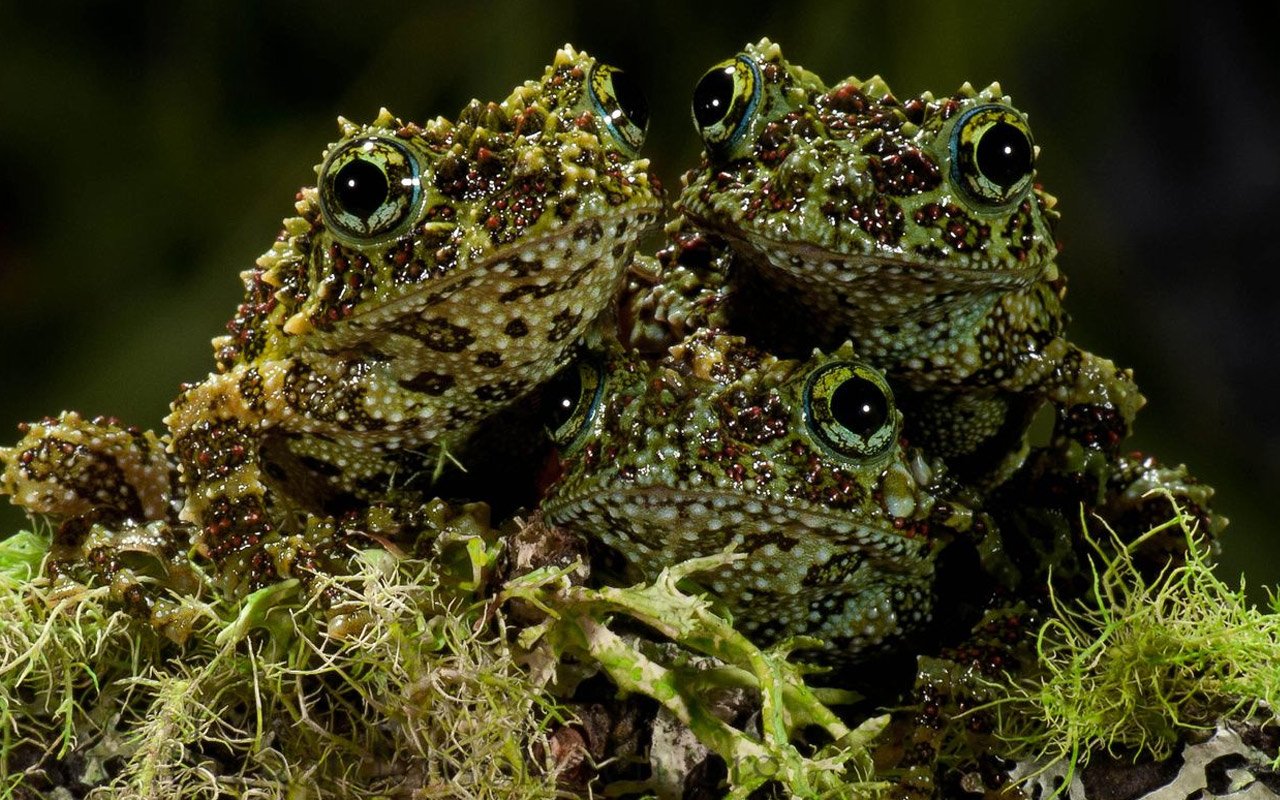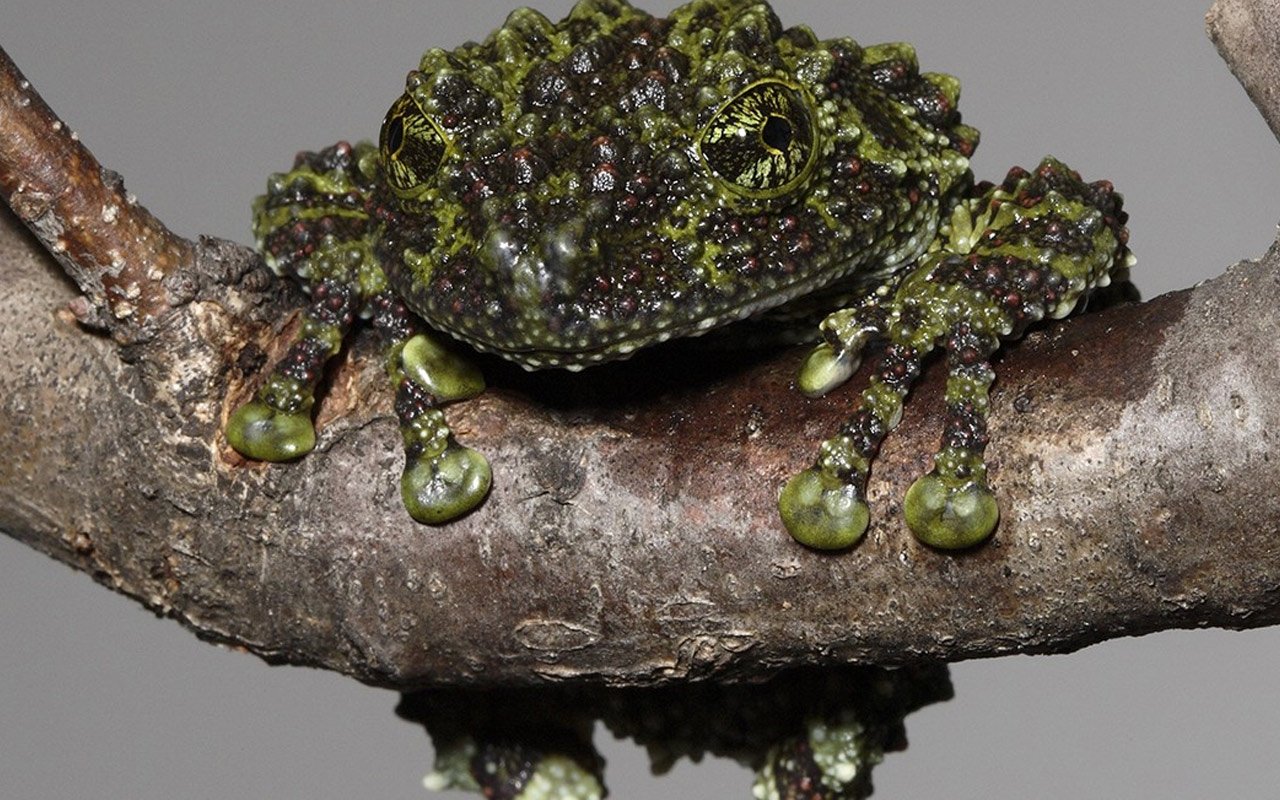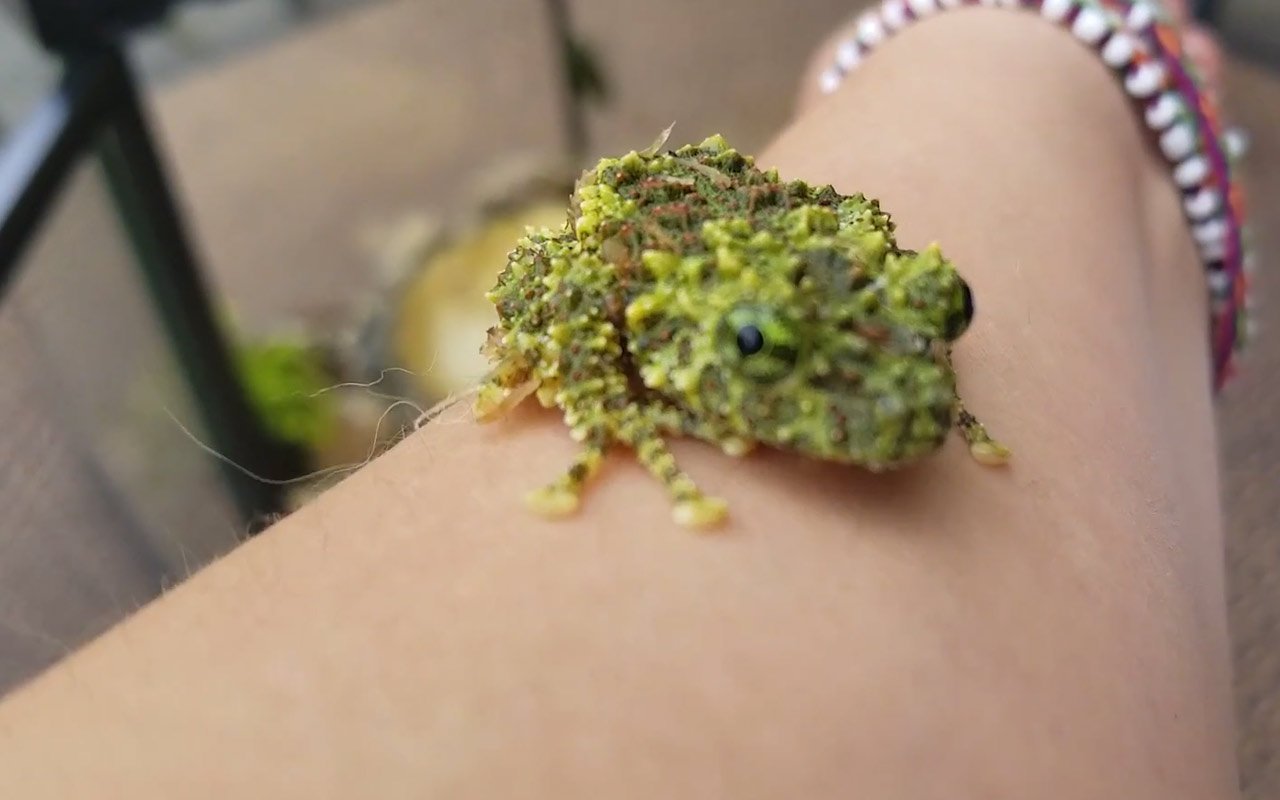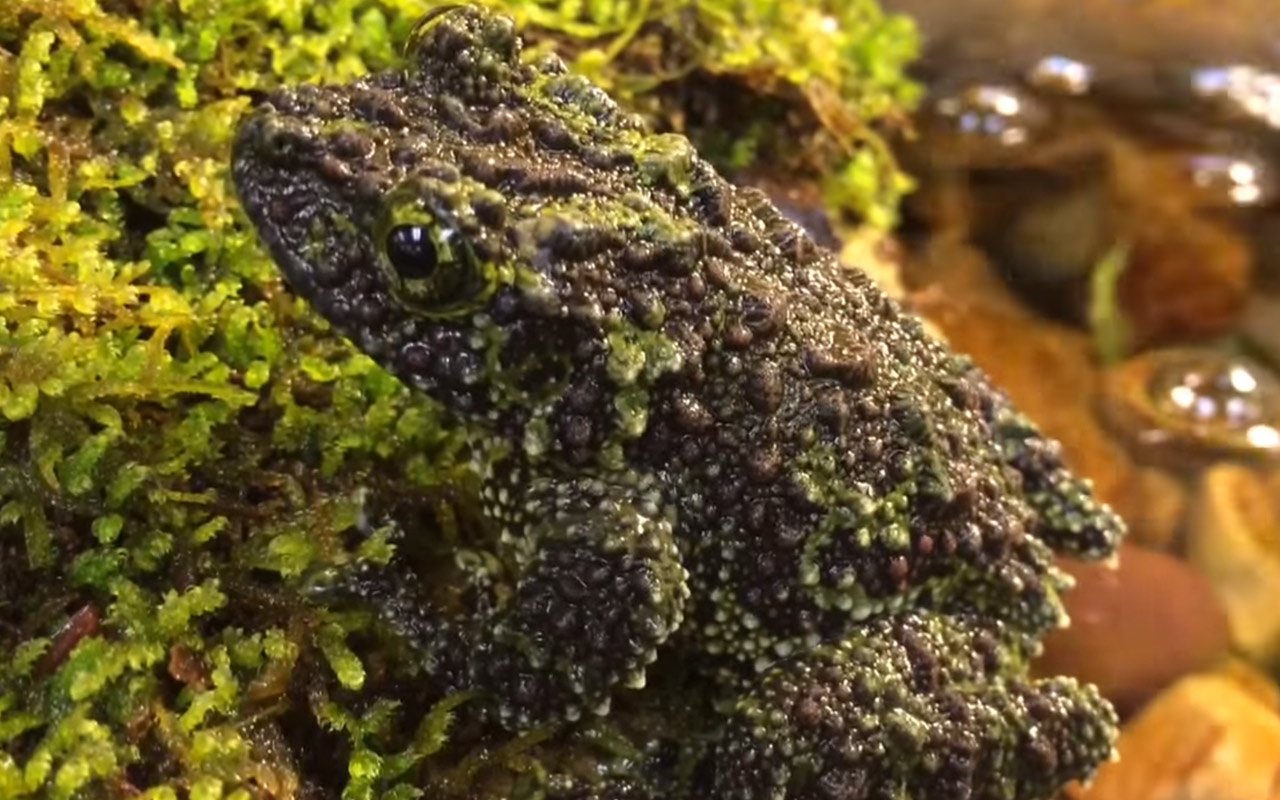It looks like a clump of moss because of its combination of the Vietnamese Mossy Frog’s green body and black spines and tubercles. It pretends it is a clump moss for most of its time. These frogs, which are native to Vietnam, live in mossy caves and along the banks of rocky mountain streams.
Are you a fan of frogs? These frogs are intelligent and beautiful. These are some facts about one of our most bizarre frogs. The Vietnamese Mossy Frog is also known as Theloderma Corticale is a master of disguise and camouflage.
Mossy frogs are shy and prefer to be left alone. They should not be touched unless absolutely necessary. Vietnamese mossy frogs can only be heard at night because they are night-bound.
Its common name is due to the camouflaging abilities that the Vietnamese mossy Frog uses in hiding from predators. These frogs look like clumping moss to you, which will baffle many.
To avoid predators, they also use vocal maneuvers. The female will lay eggs above water to protect them from predators.
This article includes information about the Vietnamese Mossy Frogs habitat and lifespan. It also contains information about the Tank Setup, Breeding Facts.
Table of Contents
Description Physical
They look like a bunch of mossy frogs because they have a green and black color. They hide in crevices and water basins to keep an eye on the environment.
If they aren’t moving, it is almost impossible for them to be identified. Tree frogs are able to jump and have adhesive pads on their feet. On the inside of males’ fingers, you will see the breeding callus.

Size
The Vietnamese mossy frog can grow to as much as 3.5 inches (8-8 centimeters) long. Males are smaller and thinner than their female counterparts.
Vietnamese Mossy Frogs Care Sheet & Pet Guide
Theloderma cortical is also known as the Vietnamese Mossy Frog. It is one of the most camouflaged species. Because of their colorful skin and bumpy dermis, they make great display pets.
It is not recommended that you keep one in captivity unless you have done thorough research before buying. Your Vietnamese mossy frog will require daily care and the proper cage.
It’s easy to recreate the natural habitat of a wolf. It’s easy to water a glass tank. They require high humidity, regular cleaning, regular cleaning, a day and night cycle, and appropriately-sized crickets, which are seasoned with vitamins, minerals, and regularly cleaned.
At the time of writing this care sheet, it was unknown how long Vietnamese mossy-frogs lived. You can expect to live for at least 10 years. The Rosamond Gifford Zoo states that a captive animal can live for between 12-15 years.
Vietnamese mossy frogs mature to 2.5-3 inches in length. The adult female Theloderma cortical ranks at the top of this scale. Males tend to be smaller, with slimmer heads and bodies.
Vietnamese Mossy Frog cage Setup
An enclosure should contain at least 10 gallons for a Vietnamese mossy frog. The enclosure should contain at least 10 gallons, with an additional 5 gallons per frog.
Glass terrariums or aquariums with screen lids are a great choice. Although it is possible to keep up to four fish in one tank, it is not recommended.
These semi-aquatic fish require large tanks with a full bottom or partial bottom and moderate to high humidity.
- Glass aquariums and glass terrariums that can be sized to suit your needs
- Large bowl with water or full water bottom
- Tannin-rich water
- Food bowl floating on water
- Natural cork bark or similar land structure
- Most covers or hides are made from cork bark and other decorative materials.
Both fake and live plants can be used. This species is nocturnal so special lighting is not required.
For live plants, however, lighting is necessary. To stay healthy, Vietnamese mossy frogs do not require lighting.
A Terrarium that measures 24x18x18′ is large enough to accommodate 2 – 4 frogs. Two Vietnamese Mossy Frogs can be housed in a 18x18x18
The same size tank or aquarium can be used. You can get larger tanks.
Lighting
Vietnamese mossy frogs don’t require special lighting. Lighting is required if you keep live plants.
The blue or red “nightlights” are great for keeping your pet awake at night. This should not be confused with a heat lamp.
Please refer to the Temperature section for more information.
Temperature
Vietnamese mossy frogs can be kept at room temperature. Temperatures between 65 – 75 degrees Fahrenheit are suggested.
Because of their cool habitats, this species is unlikely to be affected by temperatures below 60 degrees F.
Temperatures above 80° Fahrenheit or higher are considered dangerous and can cause stress and even death.
Substrate
It is simple to select a substrate for your Vietnamese Moist Frog. They require water and both land to survive.
The enclosure may be filled with water and natural cork bark placed around it. This gives them hiding spots and makes it easier to sit or climb.
You can also choose hard-scape materials such as rocks or medium-sized gravel. You can be as extravagant or simple as you wish.
It is possible to make a naturalist vivarium for Vietnamese mossy Frogs using gravels, rocks, cork bark, live plants, and real moss.
When creating a vivarium, you will need to use a soil-mixture substrate. Make sure you do your research. Poorly drained soil can pose problems for plants as well as frogs.
It is simple: Give land or water areas with many hiding places.
Water Quality
Vietnamese mossy frogs thrive on high levels of organics, and in tannin-rich waters. It is possible to get sick from drinking too much water, but not enough.
Tea-colored water is not unusual. I suggest adding an Indian almond tree branch. Frogs need safe, dechlorinated drinking water.
Every two weeks, they should receive a partial (up to half) water change. This guide provides detailed information on how to provide safe water for amphibians.
- Dechlorinated water
- A partial water change every other week
- Use an organic, tannin-rich such as Indian almost leaves
- Water should be kept in the enclosure for 2 to 4 inches
As I said, I recommend adding Indian almond leaves or organics that have high levels of tannin. Oak or magnolia leaf can also be used.
The wild Vietnamese mossy frogs live in natural water bodies that contain soil, tree roots, or other organic matter. Tree leaves can cause water contamination by falling into the water and then decomposing.
This causes the water to release tannins. This lowers the pH and gives water a murky or yellowish color.
Blackwater extract is another popular product that frog lovers all over the world use. Blackwater extract is available online and at your local pet shop.
It would be difficult to complete the water quality section without mentioning the harmful effects of chlorine on amphibians.
Regular tap water can cause damage to frogs in many cases. There are, however, a few solutions.
- Allow the water to stand for 24 hours in order to dechlorinate.
- ReptiSafe water conditioners can be used to quickly and safely dechlorinate.
- It is much better to use bottled water rather than tap water.
You should do a partial water change once a week, but not every day. For Vietnamese mossy Frogs, this can prove dangerous.
Humidity
The humidity range recommended is between 60% and 90%. Semi-aquatic fish will have a portion filled with water.
This increases humidity. The humidity will not be maintained high enough by this alone. It is enough to mist the cage two or three times per week.
You can also use moisture-retaining substrates. To cover 75% of the tank’s top, you can cover the screen lid with glass or plastic.
An automated fogger or misting system might be an option.
Paludariums
Keepers often create naturalistic environments with fish, moss, or plants. Keepers who keep mossy frogs require both water and land, so they create a naturalistic environment.
First, you must consider the needs of your pet and then create a plan to accommodate them. This is a huge topic, so I won’t go into details about creating a functional mini-biome.
Here are some ideas for fish and plants that will be friendly to frogs.
Plants
Before placing the plants in your Vietnamese mossy tank, wash them with dechlorinated water.
Be aware of the tank’s dimensions and the plants’ sizes. It is easier to care for small plants that are slower-growing.
- Living Moss – This frog is well-known for its mossy appearance and makes a great addition to a terrarium. Moss can be difficult to keep alive. It is better to place the moss in a well-draining substrate. Pillow moss is another popular choice.
- Peace Lily- The leaves of a peace Lily are a little too generic for my liking. But that is not why it was suggested. People love the roots of this plant. Peace Lily’s support creates a shoreline appearance with roots reaching into the ocean.
- Golden Pothos is a common reptile-terrarium plant. This vine can either be planted directly in the background or on the substrate.
Fish
Many small, peaceful fish will fit in your Vietnamese moss frogs paudarium. You can find a lot of candidates by doing a quick Google search.
This section is brief and to the point. These are just a few of my suggestions. Zebra danios are my favorites, as well as tetras.
Wood
Avoid terrarium branches or logs that are high in tannins if you want to preserve the water’s purity. If you have to, choose strong branches.
Spider wood is low in tannins and offers many hiding spots. They look amazing!
Vietnamese Mossy Frog Diet
Vietnamese mossy frogs are nocturnal insectectivores. They eat worms, roaches, and other insects. They eat at night because they are active at night.
It is essential to replicate their natural environment as closely as possible. It is impossible to give your mossy Frog all of the insects they would find in nature, but you can feed them crickets with vitamins and minerals to keep them happy.
Give your Vietnamese mossy Frog food at night. Wait for 10 to 15 minutes before turning off the lights. You can also place your food in the cage before you turn on the lights.
You can ensure your pet’s health while in captivity by feeding them crickets of the correct size and vitamin powders.
Your Vietnamese mossy Frog should be fed the correct-sized crickets according to their age and size. This is a list.
- Juvenile frogs can eat 1/4-1/4″ crickets
- Adults can purchase full-sized crickets
You can give them between 2 and 3 crickets each night or 4 to 6 crickets every alternate day.
It is possible to feed Vietnamese mossy Frogs, depending on what tank they have. It is important that your crickets don’t jump into the water.
You will make them eat less and you’ll have more to clean up later. You can place the crickets in small plastic bowls that are large enough to stop them from jumping out. You can place the bowl on land or in water.
Breeding
Although the United States is witnessing an increase in Vietnamese-mossy foosy frog captive breeding, there are still very few breeders. A Vietnamese mossy foo can be expensive, making it difficult to buy one.
This is due in part to the egg-to-male ratio. It is not uncommon for one male to be four males in the best circumstances. Temperature also plays a role in this factor.
According to reports, tadpoles that are raised at lower temperatures (60 degrees Fahrenheit) tend to produce more females than those that are kept at room temperature.
The results were approximately 25% female and 75% male, as mentioned. All-male frogs are almost always produced by tadpoles raised in water at room temperature.
Sex
It can be difficult to tell the sexuality of young Vietnamese Mossy Frogs. As they get older, it becomes easier.
As with all species of frogs, females are about 20% larger than their male counterparts. Males tend to be smaller and have shorter bodies, with slimmer hind leg bones.
You can determine if your mossy frog is having sex by looking at its nuptial pads. A male Vietnamese mossy frog is fully mature and has nuptial pads which are either pink or red on its front legs.
- Females are about 20% larger than their male counterparts.
- Males’ front legs are covered with red or pink nuptial pads.
In the juvenile or froglet stages, it is hard to determine the sex of mossy Frogs. It is not surprising that the local breeder may not guarantee the sex. Many mossy frogs are sold young when sex remains unknown.
Mating
Captivity allows you to control when your frogs will mat. This species has a higher success rate when it has multiple male partners. You should have at least 2 to 3 males and one female in your enclosure.
If your frogs start calling, it’s a sign they are ready to formate. This occurs most often in the morning or shortly before sunrise.
Fertilized eggs should be placed at the waterline. They will eventually fall into the water and the tadpoles may develop within 14 to 21 days.
Tadpoles & Froglets
My research has led me to two ways to care for and feed tadpoles in Vietnam. Both of these methods have been successful. The egg stage is initial and most important. It begins before the tadpoles are fully developed.
Add the eggs to a bowl and add some water. The eggs will eventually absorb lots of water and will soon swim like tadpoles. The eggs can be left in their cages with their parents. You can leave the tadpoles alone for 2 to 4 weeks.
When they reach the tadpole stage, it is best to separate them into smaller groups of six to eight per container. Each container should have approximately 2 inches worth of dechlorinated water.
To balance the pH levels and protect the water, you can add an Indian almond leaf to it. Mix crushed crickets with dried spirulina for the tadpoles.
Keep the water temperature between 60-70 degrees. Once or twice per week, do partial water changes. The number of tadpoles in each container will impact the transition from a tadpole into a frog.
According to keepers, houses are more likely if they’re kept in pairs than if kept together. On average, it takes between 4-6 months.
The metamorphosis of a Vietnamese mossy frog.
Once your Theloderma frosty is born, you should add a small amount of land to the container. Their container should be expanded to accommodate their growing needs.
At this stage, a shoe-box-sized container is sufficient. You could also give them small crickets with vitamin and calcium supplements. Start by giving them small crickets.
Allow your froglet to have some food before you take out any other crickets.
After six months, your young Vietnamese mossy frog will measure approximately 2 inches in length. They are now ready to be placed in their full-sized cage.
Handling Your Vietnamese Mossy Frog
You can keep Vietnamese mossy frogs as pets for your children.
You can consider Vietnamese mossy or mossy-frogs “display pets.” Your frogs’ health can be affected if they are exposed to too much stress. You can handle your frogs occasionally to help them move between cages.
It has been noted that Mossy Frogs can jump (pun intended). You can avoid your pet Theloderma falling if they don’t leap out of your hands.
Frequently Asked Questions About Vietnamese Mossy Frog
What type of animal is the Vietnamese Mossy Frog, and what are its characteristics?
The Vietnamese Mossy Frog, Theloderma Corticale, is a frog. This animal belongs to the Anura family Rhacophoridae.
What class is a Vietnamese mossy frog?
The Vietnamese Mossy Frog, like all other frogs of the same species, falls under the Animalia category.
What number of Vietnamese-mossy Frogs are there in the World?
Unfortunately, we don’t have enough information or data to give a complete picture of the number of Vietnamese Mossy Frogs that are currently on Earth.
These species were discovered in many surveys that were conducted in Vietnam, despite not having much data. These frog species were kept in captivity at zoos and private collectors.
An in-depth examination of the conservation status of these frog species and trends in their population can provide a glimpse into the Vietnamese mossy Frog population.
The International Union for Conservation of Nature (IUCN Red List) has designated these animals as the least concerned. Their numbers have decreased over time because of habitat loss and deforestation.
Is there a Vietnamese mossy frog living in your backyard?
Named after the Vietnamese mossy, this species of frog is native to Vietnam, especially Northern Vietnam. Although it is also found in China, only a few locations have it. These frogs are found in dense, green rainforests.
What is the habitat for a Vietnamese mossy Frog?
This semi-aquatic frog lives in dense evergreen forests in northern Vietnam, China, and other parts of China as their primary habitat. These frogs are found all over the world, in areas that have abundant or natural habitats.
They prefer elevations between 2300-3280 feet and 700-1,000 meters above sea level. These evergreen forests are found in both temperate and tropical areas.
Who are the Vietnamese mossy Frogs?

The social behavior and habits that the Vietnamese mossy Frogs display are not well understood. As with many species, these amphibians prefer to live in large groups. These frogs are social and enjoy each other’s company. They form large groups all over their habitat.
What is the maximum lifespan of a Vietnamese mossy Frog?
Because of the lack of research, it is not known how long the Vietnamese mossy Frog will live. They can be kept in captivity for up to five years.
If they are kept in zoos, it is possible for them to live up to 10 years. If they are kept in good conditions, this species of captive-bred Frog could live as long as 20 years.
How do they reproduce?
The breeding season of Vietnamese Mossy Frogs, Theloderma Corticale (theloderma corticale), is between April and June. To protect them from predators, the frog’s mate in rock cavities.
The females then lay eggs above water. The species can produce between 8-10 eggs per clutch. The eggs hatch within one to two weeks.
The eggs are laid so that newly hatched Tadpoles may drop into the water. Metamorphosis is also possible for the Vietnamese Mossy Frog.
It takes three months to complete the transformation of these frog species, from a young one to an adult.
How do they fare in conservation?
The International Union for Conservation of Nature (IUCN Red List) has designated this species as the least concern. These frogs don’t face imminent danger, and they are not at high risk of becoming extinct.
Their population is increasing. The main reasons for the decline in population are human activities like deforestation and the destruction of their habitats. The illegal pet trade also affects many other species of frogs.
How do Vietnamese mossy Frogs look?
These frogs can be described as clumps of moss because of their names. Frogs are green with dark and black spots on their bodies. Due to its presence of tubercules or spikes on the skin, this frog is more rugged than other species.
They are easily misidentified and overlooked due to their unique appearance. These frogs have distinct pads on their toes. These pads are very adhesive and enable them to climb trees or rocks to escape from their attackers.
They are adorable!
Even though they are tiny, these frogs are cute. Because of the moss, they have all over their bodies, many people consider them ugly.
What can they do to communicate?
The Vietnamese mossy frog (Theloderma Corticale), uses communication techniques that are only available to this species. These frogs can camouflage well, which helps them survive in the wild.
They communicate via vocal communication. The croaks of these frogs can be modulated using their own voices.
You may also be able to hear their voices or sounds from far away. This can make it difficult for you to locate them in your natural environment.
Hear the sound of a Vietnamese mossy frog
What size are Vietnamese mossy Frogs in terms of size?
The Vietnamese mossy-frog (Theloderma Corticale), is a very common species.
They measure approximately 3.5 inches (8.9cm) in length. They look very similar to the Vietnamese mossy which is an adult frog measuring 2.4 to3.5 inches (or 6.1-8.9 cm).
What speed can a Vietnamese mossy Frog swim in the water?
We don’t know how fast the Vietnamese Mossy Frog swims. These semi-aquatic frogs are thought to be skilled swimmers.
How much does a Vietnamese mossy Frog weigh?
The weight of Theloderma Corticale, also known by the Vietnamese Mossy Frog is not available. Their weight can be estimated because many species in the Rhacophoridae family are similar and alike. These tiny creatures typically weigh in at 1.8 oz (51g).
What are the male and female genders of this species?
Because neither the male nor the female was given a name, they are called Vietnamese mossy or Vietnamese mossy frogs. It is interesting to notice the collective noun “frogs”. An army is a group or individuals of frogs.
What would you call a baby Vietnamese mossy frog?
Baby froglets are called froglets. The baby would then be called a Vietnamese mossy frost let. After the eggs are hatched, the tadpoles will be born. A baby Vietnamese mossy Frog is also known as a tadpole.
What are they eating?
These frogs are either carnivorous, or they eat mostly insects. These frogs eat only insects. The frogs can eat many insects including crickets, earthworms, and cockroaches. They live mainly below floating plants.
Are they toxic?
It is unknown if these frogs are poisonous.
They could make a wonderful pet.
These frogs are suitable for keeping as pets. These frogs are shy and should be avoided being kept as pets. These animals can be kept in captivity if the right conditions are met.
These frogs need to be kept in an aquarium. It is also important to replicate the ideal temperature for a forest setting. It should be below 75 F (23 C), but not below 50-60 F (10-15 C).
Did You Know…
When they feel threatened or afraid, these frogs will either curl up or fold their bodies.
Batrachochytrium, a fungus that can have severe effects on the health and well-being of frogs, has been identified.
How does a Vietnamese mossy Frog defend itself?
These frogs are adept at camouflage and disguise. Because of their appearance, they are often mistakenly thought to be moss. If they are ever in danger, these animals will play dead.
What number of species make up the Vietnamese mossy-frog genus?
The Rhacophoridae Family includes Vietnamese mossy frogs and frogs. This is the Old World tree and the frog family. It is difficult to determine the exact number of species in this family, as species are constantly being reclassified and classified.
There are more than 300 species of frogs in the Rhacophoridae family.
WHERE TO FIND THE VIETNAMESE MOSSY FROG
You can view these Vietnamese mossy frogs at Smithsonian National Zoological Park, 3001 Connecticut Ave NW, Washington, DC 20008


